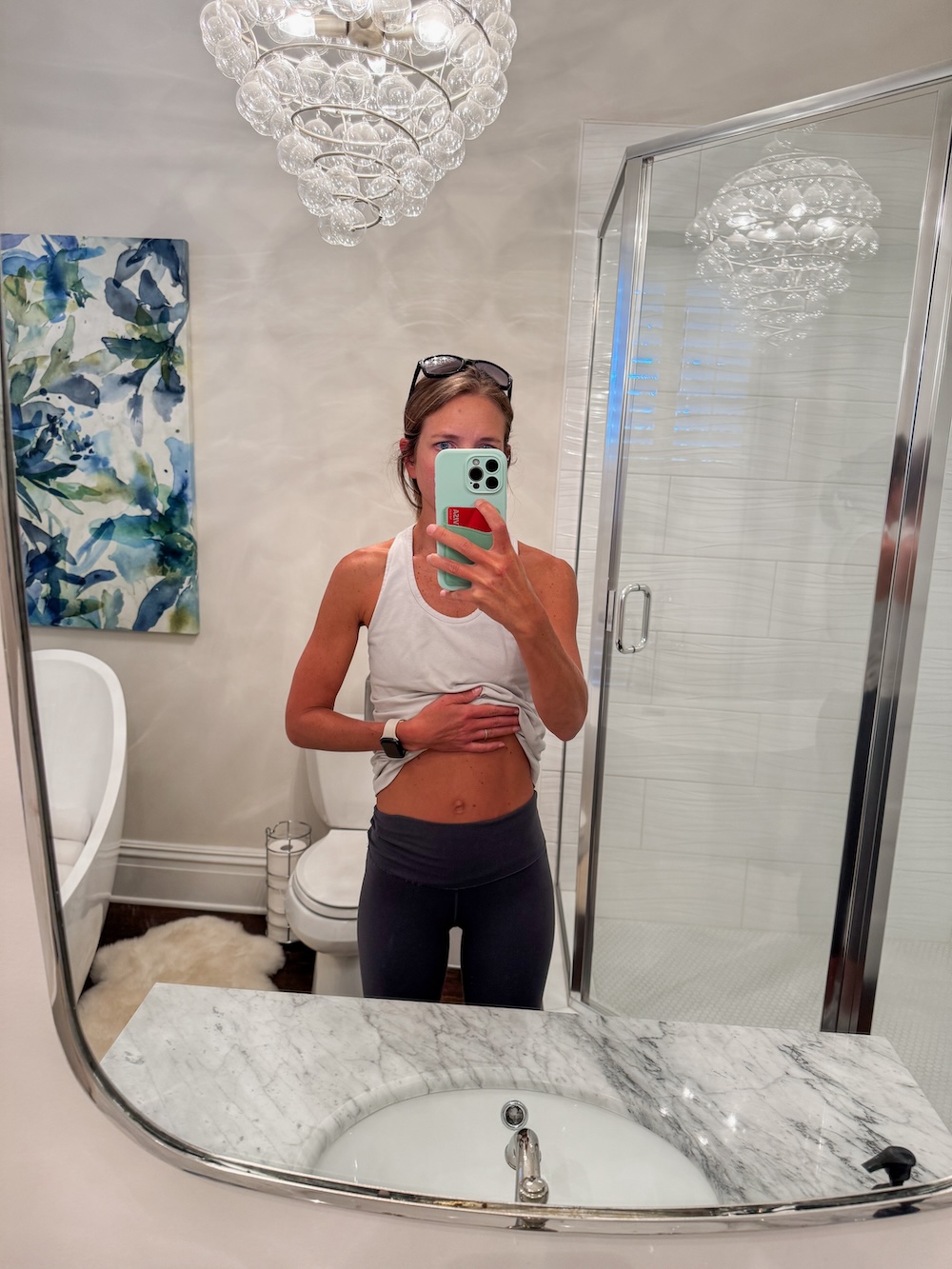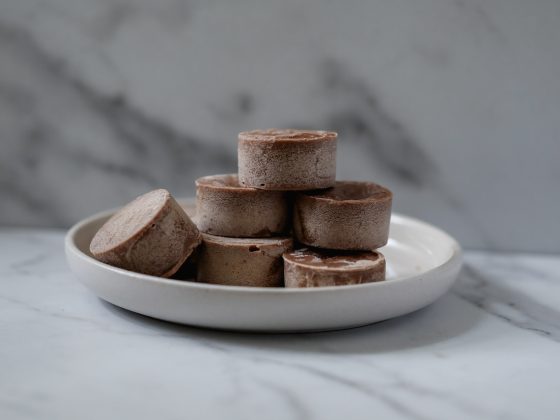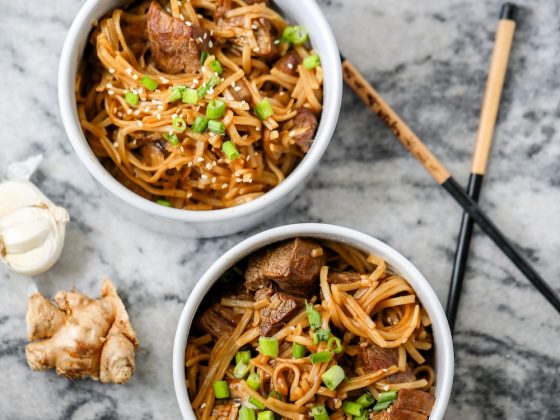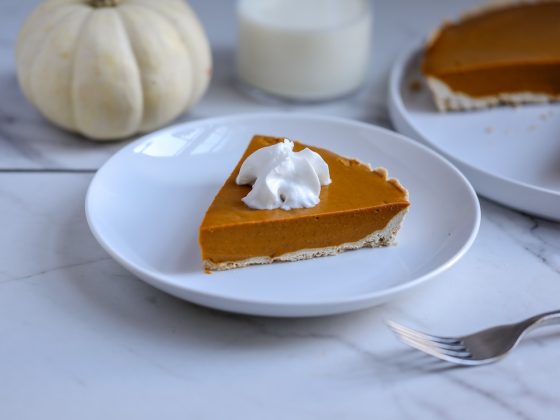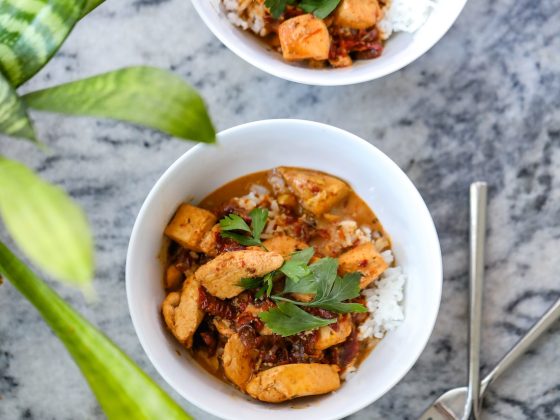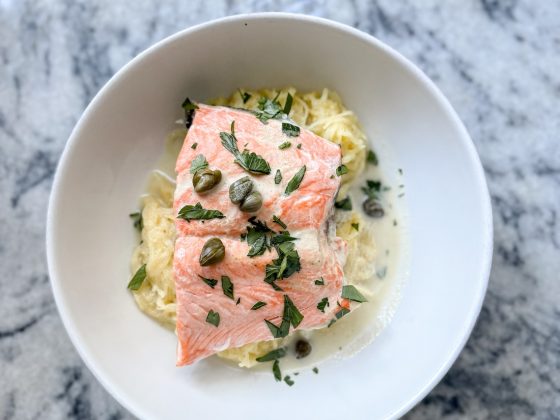My Gut Healing Wake-Up Call
I have never really identified as someone with “gut issues.” For most of my adult life, I considered myself a healthy person with a pretty strong digestion. I ate well, exercised, and had worked hard to better my relationship with food after years of ups and downs in my twenties and early thirties. But after having my second baby, everything changed.
Around five months postpartum, I started noticing that something just felt “off.” I was constantly bloated (so much so that I still looked pregnant), chronically constipated, and would experience debilitating fatigue after meals.

At first, I brushed it off as normal postpartum “woes,” but deep down, I knew this wasn’t how I was supposed to feel; my intuition told me it wasn’t normal at all. With the guidance and encouragement of my acupuncturist (who also happens to be a functional medicine practitioner), I decided to dive deeper into my digestive health. Through a series of tests (bloodwork, stool analysis, and a breath test) I learned that I had methane SIBO (small intestinal bacterial overgrowth), gut dysbiosis, and even a parasite called Blastocystis Hominis. To say I was overwhelmed would be an understatement. It felt like my body had been speaking to me for months, but I hadn’t been listening.
Looking back now, this experience completely reshaped the way I view food, and solidified my beliefs in personalized nutrition. It taught me the importance of bio-individuality, the power of functional testing, and the difference between following trends online versus tuning into your own body. This is what actually helped me heal, and what didn’t.
How I Discovered I Had SIBO
At first, my symptoms seemed like classic postpartum struggles: bloating, constipation, fatigue. But as the months went on, they only got worse.
Here’s what I was dealing with:
- Daily bloating, constipation, and discomfort that made me anxious about what to eat.
- Persistent hunger, even after eating balanced, high-protein meals.
- Extreme fatigue after eating, especially dinner.
- Intense sugar cravings that made me reach for a sweet treat after both lunch and dinner.
I tried to rationalize my symptoms. I did just have a baby; I was breastfeeding, barely sleeping, and juggling two kids. But something told me this wasn’t just postpartum recovery.
That’s when my acupuncturist suggested running a few tests. My bloodwork results came back first. They revealed signs of dehydration and kidney strain (likely from eating too much protein). My stool test showed gut dysbiosis and a parasite, which can throw the microbiome completely off balance. And my breath test confirmed methane SIBO, meaning bacteria that should have stayed in my large intestine had migrated to my small intestine, fermenting food and creating gas, bloating, and inflammation.
Suddenly, everything made sense – the bloating, the fatigue, the weird hunger cues. SIBO wasn’t the root cause itself, but a symptom of deeper issues: slow motility, chronic stress, low stomach acid, and an overgrowth triggered by infection.
It was validating to finally have answers, but it was also overwhelming. For example, eating to replenish the beneficial bacteria can contradict eating to heal from SIBO. Not only did I feel lost, but I had to rethink everything I thought I knew about “healthy eating” and start rebuilding from the inside out.
What Didn’t Work
Once I finally had all of my test results in front of me, I wish I could say I knew exactly what to do next. But honestly, I was completely overwhelmed and anxious about what to eat. Like most people, I turned to the internet and social media, trying to piece together the “perfect” gut healing diet. I would find myself down various Reddit rabbit holes , only to be confronted by a list of contradictory nutrition advice. Here is what I learned the hard way: even the best information can become confusing (and sometimes harmful) when you don’t filter it through your own bio-individuality.
Too Much Protein
Before the diagnosis, when I as trying to lose the baby weight, I was following what what everyone online seemed to be saying: eat higher protein and healthy fat while lowering carb consumption. I was even tracking my macros, focusing on blood sugar balance, and was eating 120–140 grams of protein a day. On paper, it looked “healthy.” But my body told a different story.
My energy was tanking, my digestion felt sluggish, and my lab results reflected it: elevated BUN, creatinine, and albumin, which can indicate dehydration and difficulty metabolizing protein. Basically, I was eating more than my body could handle.
In hindsight, I think my over-focus on protein got me into this mess. While unconfirmed, I believe slow motility was one of my root causes, and once I started decreasing my protein and focusing instead on digestibility — pairing smaller portions of protein with gentle, easy-to-digest carbs — I immediately noticed a difference. My bloating decreased, my meals felt lighter, my energy steadier, and my body finally started to feel as if it was in a more balanced state.
Carnivore and High-Protein “Healing” Diets
Because I had SIBO, I was told that carbohydrates “feed the bacteria,” so I tried cutting them out almost entirely for a few days, even flirting with the idea of going carnivore. I thought starving the bacteria was the only way to heal.
But almost right away it was clear this shift wasn’t going to work. My digestion seemed to slow even more, which just reaffirmed what I was thinking: I need to take the focus off of protein, and instead look through the lens of digestibility.
The truth is, SIBO isn’t caused by carbs, it’s caused by bacterial overgrowth in the wrong place, and the real healing happens when you address motility, inflammation, and the gut environment, not when you restrict a whole food group.
Over-Restricting “Gut-Friendly” Foods
In the beginning, I tried to do everything “by the book”: low-FODMAP, low-histamine, dairy-free, gluten-free. But soon my world of “safe foods” became smaller and smaller, and I was developing food anxiety all over again.
That was heartbreaking because I had worked so hard to heal my relationship with food. I realized that in trying to control my symptoms, I was creating more stress, and stress, of course, only worsens digestion.
So I gave myself permission to experiment with curiosity instead of fear. That mindset shift became one of the biggest catalysts for healing.
Antibiotics and One-Size-Fits-All Protocols
I learned quickly that there wasn’t going to be a “quick fix.” It was going to be a process of a supplemental protocol coupled with nutritional changes. I really got into a groove with my protocol about four months in, and it wasn’t until six months later that I found myself thinking I think I have healed my gut!
On that note, I think it is important to address the fact that I never tried antibiotics. Primarily because I have (had?) methane-dominant SIBO. Methane SIBO doesn’t really respond to antibiotics, as it is not bacteria alone. it’s driven by methanogens, which are microbes that behave more like archaea than bacteria. These organisms produce methane gas as they feed on the food we eat, particularly carbohydrates, and that methane slows everything down in the digestive tract. The slower your motility, the longer food and bacteria sit in the small intestine, which just feeds the cycle.
This is also why methane SIBO is harder to eradicate. Most antibiotics are designed to target bacteria, not archaea, so they don’t fully eliminate the methane-producing organisms. You might feel better temporarily after a round of antibiotics, but unless you address the root cause — things like sluggish motility, low stomach acid, or underlying infections (like a parasite or dysbiosis, which I also had) — the overgrowth often comes back. This is why it was important for me to address the underlying causes, rather than apply a band-aid approach.
Essentially, I knew that true healing required patience, nutritional support, and trust in my body’s ability to rebalance itself, not a quick fix. For me, the real progress came once I shifted from trying to “kill” the overgrowth to supporting my body’s natural ability to digest, detoxify, and move food through the gut efficiently. That meant focusing on hydration, warm cooked foods, stress management, and gentle motility support.
What Did Work
Supplements
When I first started out as a health coach, I often heard the phrase “food first, supplements second.” That idea stuck with me early on. I believed that if you simply ate well enough, your body would get everything it needed, and supplements were only for certain circumstances. Over time, my perspective completely shifted. I genuinely don’t think I would have healed my gut without a targeted supplement protocol. I’ll spare you the long list of capsules and powders I took daily, but here are the few that truly moved the needle:
- Motility Pro (here is a similar product on Amazon)
- Klaire Labs SpectraFiber
- Enzymedica Digestive Enzymes
- Enzymedica Betaine HCl
- Klaire Labs Saccharomyces Boulardii Probiotic
Decreasing Protein & Eating for Digestibility
One of the first changes that made a noticeable difference in my healing was reducing how much protein I was eating and focusing instead on how well I was digesting my food.
For years, I followed the high-protein, blood-sugar-balancing approach that’s so popular in the wellness world. At one point, I was eating 120–140 grams of protein a day: eggs and sausage at breakfast, chicken at lunch, beef at dinner, protein powder in my smoothies. On paper, it looked healthy, but my body was telling me otherwise.
When my functional medicine practitioner ran my bloodwork, several markers stood out: my BUN (blood urea nitrogen), creatinine, and albumin levels were all elevated. These are indicators related to kidney function, hydration status, and protein metabolism. High levels can suggest that your body isn’t efficiently clearing waste, which can happen when you’re over-consuming protein, under-hydrated, or your digestion and detox pathways are compromised.
For me, it was all of the above. My gut was inflamed, my motility was sluggish, and my body simply couldn’t process the amount of protein I was eating. Once I reduced my intake and focused on gentler, easier-to-digest meals, I noticed a shift almost immediately:
- My bloating decreased
- My energy and hunger cues stabilized
- The “heavy” feeling after meals disappeared
Instead of large amounts of animal protein at every meal, I started focusing on quality over quantity: smaller portions paired with easy-to-digest carbs like white rice, sweet potatoes, or millet. Not only did this improve my digestion, but it also supported my nervous system and hormone balance.
This was a big mindset shift for me. For so long, I was afraid that eating fewer grams of protein would mess with my blood sugar or muscle tone, but what I realized is that digestibility matters more than density. If your body can’t properly break down and absorb what you’re eating, it doesn’t matter how “perfect” the macros look on paper.
Looking back, decreasing protein was one of the first steps that helped calm inflammation, reduce the burden on my gut, and set the foundation for deeper healing.
Water-Based Cooking
The next major turning point in my healing came when I unintentionally started practicing what I now call water-based cooking: preparing foods by steaming, simmering, poaching, or cooking in broth or water instead of oils or dry heat.
At the time, I didn’t realize that this simple change would be so transformative. My functional medicine practitioner encouraged me to focus on warm, cooked meals instead of cold salads, raw veggies, or heavy stir-fries. She explained that when digestion is compromised, warm foods are easier on the stomach because they’re already partially broken down.
I’ll be honest, at first I resisted. It was the middle of summer in Richmond, Virginia, and the last thing I wanted was a bowl of soup. But I was desperate to feel better, so I gave it a try, slowly replacing sautéing and roasting with gentle steaming and simmering.
Within a couple of weeks, I noticed a difference. My bloating reduced dramatically, I wasn’t as fatigued after eating, and my skin even looked more hydrated. Over time, I began craving these soothing, nourishing meals.
I now understand why:
- Water-based cooking helps preserve hydration in the food itself, which supports digestion and cellular function.
- It’s easier on the gut lining and doesn’t introduce oxidized fats from high-heat oils.
- It creates lighter meals that are still satisfying, especially when paired with mineral-rich broths and seasonal produce.
This style of cooking has become my newfound foundation for my food philosophy. It’s the approach that ultimately inspired my Water-Based Cooking E-Book, because it’s not about restriction; it’s about cooking in a way that helps your body heal and thrive.

Even now, I notice the difference immediately when I drift away from this method. If it is the weekend and we are eating out at restaurants (where everything is cooked in oil) my digestion feels sluggish again. One or two days back to soups, stews, and steamed veggies, and I’m back to my baseline.
Water-based cooking taught me that sometimes healing doesn’t require another supplement or protocol, it simply asks you to change the way you cook your food.
Supporting Motility
When it comes to healing SIBO, supporting motility — or the natural movement of food through the digestive tract — is absolutely essential. In fact, sluggish motility is often one of the underlying root causes of methane SIBO, because when things move too slowly, bacteria have more time to ferment food in the small intestine.
For years, I had unknowingly been working against my gut’s natural rhythm. Stress, too frequent meal timing, and mindless eating all contributed to my digestion slowing down. Once I learned this, I started building habits that supported my motility instead of hindering it.
Here’s what made the biggest difference for me:
- More mindful eating. I started paying closer attention to how I was eating, not just what I was eating. Instead of standing at the counter or scrolling on my phone, I made a point to sit down, take a few deep breaths, and chew slowly. This small shift helped activate my parasympathetic nervous system — the “rest and digest” state — so my body could actually absorb and process the nutrients. Mindful eating made meals feel more grounding and peaceful, which in turn supported smoother digestion and better motility overall.
- Meal timing. Before pregnancy, meal timing wasn’t really an issue. But throw intense hunger with pregnancy and postpartum into the mix, and well, I wasn’t spacing meals out in the way that supports digestion. Ideally, meals should be spaced every three to four hours; this allows the body’s natural “cleansing wave” (the migrating motor complex, or MMC) to activate between meals and sweep bacteria down into the large intestine where they belong.
- Walking after meals. Even a gentle ten-minute walk can help stimulate digestion, reduce bloating, and encourage movement through the gut.
- Staying hydrated with mineral-rich fluids like broth and filtered water. Hydration is key for bowel motility, especially when recovering from constipation-dominant SIBO. My functional medicine practitioner eventually encouraged trace minerals a couple of times a day, and that supplement has been a game-changer.
- Managing stress. I went through a very stressful period for a few years after my son was born. It’s no coincidence that was the period when these gut issues started. Our gut and nervous system are deeply connected. Things have calmed down since, and I have tried to slow down in general, which I believe is an important part of my gut healing journey.
- Acupuncture and gentle movement. My bi-monthly acupuncture appointments coupled with my daily walks have played a big role in resetting my body’s rhythm.
What I love about these practices is that they’re simple, free, and sustainable. Supporting motility isn’t about doing more, but about creating the conditions for your body to do what it’s naturally designed to do.
Simplifying Nutrition
After years of trying to figure out the “right diet,” I have finally let those mindset shifts go. If I am being honest, these behaviors around food were directly link to some deep-seated beliefs about my body and relationship with myself. I thought there was something to “fix,” and my relationship with food reflected that. Eventually, every meal felt like a math equation, and I just got tired of crunching numbers.
That’s when I realized that healing wasn’t going to come from more rules, it was going to come from simplifying my nutrition and getting back to basics: real, whole foods that I could digest easily and actually enjoy. I let go of the pressure and anxiety; instead of looking through the lens of weight loss, I shifted to gut health instead. I went from fear to curiosity. If a food left me bloated or fatigued, I took note. If it left me satisfied and energized, I kept it in rotation.
Simplifying nutrition also meant finding a rhythm that worked for my body in this season of life. That looked like warm, cooked meals, gentle carbs for energy, smaller portions of protein, and foods that felt grounding, not stressful.
In a world where wellness often feels complicated and extreme, this was a return to more of a middle way. The less I micromanaged my food, the more my body responded with ease.
Lessons Learned
Looking back, healing my gut wasn’t just about food or supplements, it was about completely reshaping the way I approached wellness. I used to think healing meant doing more: more rules, more restriction, more control. But true healing required the opposite. It asked me to slow down, simplify, and trust my body again.
Here are the biggest lessons I’ve learned along the way:
- Healing isn’t linear. There were good days and hard days, and that’s normal. The body doesn’t heal on a straight timeline, it heals in layers.
- Bio-individuality is everything. What works for one person may not work for another. To take it up a notch, what works for you in one season of life might not work for you in another. The most powerful thing you can do is learn to listen to your own body’s feedback.
- Stress affects digestion more than food does. I could eat the cleanest meal in the world, but if I was anxious or rushing, my gut would react. Mindfulness at mealtime matters.
- Simple is sustainable. When I focused on easy-to-digest, nourishing foods rather than chasing the next “perfect” plan, my body began to respond.
- Awareness creates freedom. Once I understood my triggers and my tools, I no longer felt restricted. I felt empowered.
More than anything, I’ve learned that healing isn’t about perfection; it’s about presence. The more I supported my body with warmth, patience, and curiosity, the more it supported me in return.
Where I Have Landed
After months of experimenting, unlearning, and rebuilding, I finally feel like I’ve landed in a more peaceful place, both with food and with myself. My digestion is no longer something I have to think about all the time, and that alone feels like freedom. About 95 percent of my symptoms are gone. On the rare days when I do feel bloated or off, I now know exactly what to do to bring my body back into balance, usually just a day or two of gentle, water-based meals, hydration, and rest.
I’ve learned to trust the process and to trust my body. I no longer chase adhere to dietary labels. Instead, I focus on what feels nourishing, grounding, and sustainable. My meals are simple — soups, stews, steamed veggies, and easy-to-digest proteins — but they make me feel energized and balanced.
What began as a frustrating and confusing chapter in my health has become one of the most clarifying experiences in my wellness. When we learn to listen to our bodies, slow down, and meet ourselves where we are, everything starts to shift.
This journey also inspired something new: my water-based cooking e-book, which brings together all the recipes and principles that supported my healing. It’s not just about what to eat, but how to cook in a way that supports digestion, energy, and long-term health. Because when you nourish yourself in alignment with your body, healing naturally follows.
In Conclusion
I want to end this post by saying that I haven’t officially retested for SIBO, so I can’t say with complete certainty that it’s “gone.” But what I can say is that I feel better than I have in years. About 95 percent of my symptoms have disappeared (the bloating, constipation, persistent hunger, fatigue, food anxiety), and I finally feel like my digestion is working the way it’s supposed to. So while I can’t prove that I’ve “healed SIBO” on paper, I know my body has healed in practice.

